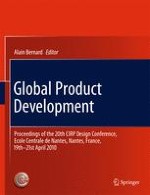2011 | OriginalPaper | Buchkapitel
Integration of Life Cycle Engineering and Multi-attribute Analysis to Support Product Development: Process Design and Material Selection for a Clothes Peg
verfasst von : C. Inácio, I. Ribeiro, P. Peças, E. Henriques
Erschienen in: Global Product Development
Verlag: Springer Berlin Heidelberg
Aktivieren Sie unsere intelligente Suche, um passende Fachinhalte oder Patente zu finden.
Wählen Sie Textabschnitte aus um mit Künstlicher Intelligenz passenden Patente zu finden. powered by
Markieren Sie Textabschnitte, um KI-gestützt weitere passende Inhalte zu finden. powered by
